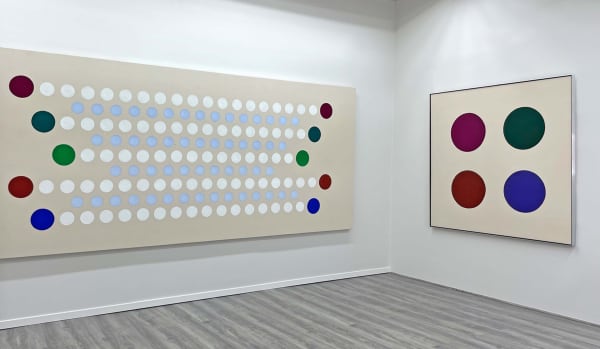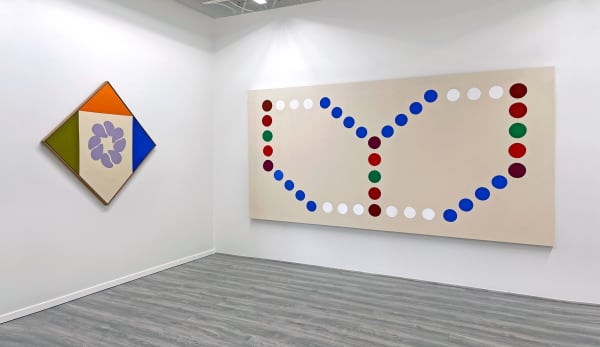Pazo Fine Art is pleased to present its new exhibition Colors of Confidence, showing eight Washington DC based abstract artists: Willem De Lopper, Thomas Downing, Tom Green, Simon Gouverneur, Jacob Kainen, Howard Mehring, Paul Reed, and Carroll Sockwell. Some of the artists from these group, such as De Looper, Downing, Green, Kainen, Mehring, and Reed, were directly associated with The Washington Color School and others clearly influenced by it as leading members of the DC arts community. Although these artists joined the movement at different stages, some like Downing, Mehring, and Reed, were founders who participated in their landmark exhibition Washington Color Painters at the Washington Gallery of Modern Art. Nevertheless, despite the evident differences in their art and the phases when they joined it, their work shows a commitment to explore the diverse tendencies of abstractionism and the experimental use of color.
This show presents us with a panoramic view of the artistic scene in the city around those decades, bringing back a vibrant and exciting time in this city in a new light.
Text by Irina Leyva Pérez.
Artists Bios:
Willem De Lopper (1932-2009), one of the most recognized artists in this group and a well- known member of the Washington Color School. He is represented in the exhibition by one of his classic pieces from 1975. It was from the period when he filled the surfaces with stripes of different withs made of diluted paint. This treatment produced the hallmark luminosity of his works during this phase. It is evident in this painting with an ochre tonality. There is spontaneity and flux in these pieces that suggest total freedom of conception. De Lopper was also a curator. He worked at Phillips in several positions, from a guard to Assistant Curator and the institution’s Chief Curator.
Thomas Downing (1928-1985), a founding member of the Washington Color School, is represented by several paintings of his distinctive colorful dots. Two pieces, Run and Split Possession are from 1972, both reflect his interest in exploring the circle as a single element and as part of a unit. He used the geometric form in many ways in his compositions but always as a protagonist. Color is the other component of his images. Together, it creates a visual rhythm that generates an optical movement. His third piece, Quadrille, explores the circle differently by enlarging it.
Tom Green (1942–2012), was also associated to the Washington Color School and taught at the Corcoran College of Art and Design for 35 years. His career spans several decades, and the piece in this show is from 1997. It illustrates Green’s work between abstraction and figuration when he created compartmentalized compositions with several sections. Sightings illustrates that formal solution, with five parts of apparently incongruous images.
Simon Gouverneur (1934-1990) is known for his compositions based on mysticism. His roots influenced him to take a multicultural approach to art and life, creating his cosmos from different sources. His work is full of symbolism taken from various spiritual sources such as Buddhism and Hinduism. Influenced by its mysticism, he included symbolic elements from them in his pieces. Snare, from 1986, shows an inherent tension between content and form through a rhombus inside a circle. His gridded works, like this one, contain symbols like the circles in this one. The Snare shows a grid-like similar to a board game with round chips.
Jacob Kainen (1909-2001) was a painter, printmaker, teacher, scholar, and curator. His piece in this exhibition, Secretary General, from 1972, corresponds to a period in his art when he returned to exploring form and color. This painting is an excellent example of the period, with a mixture of f igurative and abstract elements coexisting on a floating and vivid atmosphere. Among Kaine’s achievements as curator include his position at the U.S. National Museum from 1944 to 1966. He oversaw the prints department there. He also looked after prints and drawings for the National Collection of Fine Arts (now the Smithsonian’s National Museum of American Art) from 1966 to 1970.
Howard Mehring (1931-1978) is another well-known member of the Washington Color School. His pieces are known for the bold colors applied in large areas of geometric shapes. His painting Magenta Double, from 1964, is a great example of his work from the period with its thick bands of brilliant and contrasting colors.
Paul Reed (1919-2015) was a founder of the Washington Color School, and similar to Green, also taught at the Corcoran School of Art. His piece in the show, #12A, from 1964, shows a biomorphic shape like a flower in the center. On three corners, colorful and contrasting triangles delimit the space. This piece is part of a series he did following the series of Mandalas paintings inspired by Jungian psychology. The central figure is a clear reminder of that influence.
Carroll Sockwell (1943-1992) is represented by an untitled piece from 1980. It is an excellent example of the artist’s combination of geometric and gestural elements in his work. The piece is almost monochrome, mostly grey, and the composition is chaotic. The dark and stoic image conveys a sense of turmoil and uncertainty, transmitting anguish and despair. Sockwell also worked as curator at the Barnett-Aden Gallery in 1965-66.
July 16, 2021 - September 3, 2021
Opening reception: Friday, July 16th, 2021
4228 Howard Ave Kensington, MD 20895
Open by appointment Tuesday – Saturday
Contact Luis Pazo:
(571) 315-5279
info@pazofineart.com




